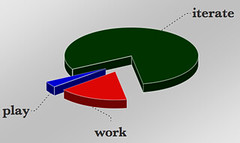The 2-Minute Task Technique: Proven by Productivity Experts
The 2-minute technique helps you overcome procrastination and build momentum by committing to start a task for just two minutes.

I struggle with getting started on tasks. Even small tasks seem enormous to me. How can I get myself to take action and stop procrastinating on tasks?
The following solution to my procrastination problem was created with Gemini, Claude, and ChatGPT AI tools. This process included providing these tools with my own thoughts about procrastination and curating ideas from other websites (see the full source list at the bottom of the page). Learn more about my process here.
The 2-minute rule helps you overcome procrastination and build momentum by committing to start a task for just two minutes. This approach is based on the idea that getting started is often the most difficult part of any task and that initiating action, even briefly, can lead to continued work and progress.
What You'll Learn:
🧠 How committing to just two minutes can help you beat procrastination and build momentum.
🔧 Easy steps to start using the 2-minute technique right away.
📚 Practical ways to apply this method to personal and professional tasks.
🚀 The pros and cons of using the 2-minute technique to manage your tasks.
🔄 Alternative methods like the 5-Minute Rule and the "(10+2)5" Procrastination Hack compared.
Overview
The 2-minute technique lowers the psychological barrier to beginning a task by committing to work on it for only two minutes. People continue beyond this initial period due to momentum and reduced resistance.
This technique is considered particularly useful for overcoming procrastination, writer's block, and general task avoidance. It can be applied to a wide range of activities, from personal projects to professional responsibilities.
Key Concepts
Inertia
Newton's first law of motion applies to human behavior: people resist action without an external push. The two-minute commitment provides that push.
The Breaking of Mental Barriers
Many people encounter mental barriers when approaching tasks, especially those they perceive as large or complex. These barriers can manifest as feelings of being overwhelmed, anxious, or uncertain about where to start. The 2-minute technique aims to circumvent these mental obstacles by presenting a small, manageable commitment that feels less daunting.
Implementing the 2-Minute Technique
To use the 2-minute technique:
- Choose a task you avoid.
- Commit to two minutes.
- Set a timer.
- Start, focusing only on the next two minutes.
- After two minutes, decide whether to continue or stop.
The key is to focus solely on starting the task rather than on completing it or achieving perfection, which can help reduce pressure and increase the likelihood of taking action.
Applications of the 2-Minute Technique
The 2-minute technique can be applied in various contexts, including:
- Starting personal projects and creative endeavors: Writers push through blocks with brief brainstorming or freewriting sessions.
- Tackling professional tasks and deadlines: Professionals tackle procrastinated tasks by organizing their inbox for two minutes or outlining a report.
Benefits and Limitations
Proponents of the 2-minute technique cite several potential benefits:
- Procrastinate less
- Boost productivity
- Reduce task anxiety
- Manage time better
- Feel more accomplished and motivated
However, the technique may not work in all situations or for all individuals. Some challenges include:
- Unsuitable for complex tasks demanding extended focus
- Challenging for individuals with severe attention difficulties
- Difficult to apply to highly complex projects that resist breakdown into small steps
Additionally, some critics argue that the technique may not address underlying issues causing procrastination or task avoidance, such as perfectionism or fear of failure.
Other Ways To Get Started On A Task
The 5 Minute Rule
The 5-Minute Rule involves committing to working on a task for just five minutes, after which you can stop if you choose.
"(10+2)*5" Procrastination Hack

This technique breaks procrastination by tricking the mind into short, focused work periods followed by rewards.
Requirements:
- A timer
- A to-do list with tasks that can be worked on in 10-minute blocks
- An hour of time
Process:
- Work intensely on one task for 10 minutes
- Take a 2-minute break to do anything
- Repeat this cycle 5 times (total: 1 hour)
Key rules:
- Focus solely on the task during work periods
- Don't skip breaks
- Move to the next task after each cycle
- Tasks don't need to be completed, just advanced
"Dash" Technique

A "dash" is a short burst of focused activity on a procrastinated task. The goal is to break the procrastination cycle by making small, achievable progress.
Types of dashes:
- Time-based: Work for a set time (e.g., 8 minutes)
- Unit-based: Complete a specific number of units (e.g., 2 pages)
- Combination: Stop when reaching either the time or unit goal
Key principles:
- Choose laughably modest goals
- Focus solely on the task during the dash
- Stop when the goal is reached (unless motivated to continue)
Benefits:
- Reduces anxiety by starting the task
- Breaks down seemingly overwhelming projects
- Often leads to continued work beyond the initial dash
Bottom Line
The 2-minute technique empowers you to beat procrastination and build momentum. Focus on starting, not completing. Make progress on your goals. While not universal, many find this method game-changing in work and life.
How to Use the 2-Minute Rule for More Productivity and Less Procrastination (Motion)
How to Use Newton’s Laws of Motion to Enhance Productivity (Akiflow)
The 2-Minute Rule: How Tiny Actions Unlock Massive Productivity (ClickUp)
Overcoming the Inertia That Inhibits Personal Growth (Psychology Today)
How to Actually Start the Task You’ve Been Avoiding (Harvard Business Review)
How to Overcome the Barriers of Getting Started (Nikolas Klein)
References
- https://medium.com/@nikolasklein/how-to-overcome-the-barriers-of-getting-started-bc6374df67f5
- https://www.usemotion.com/blog/2-minute-rule
- https://akiflow.com/blog/newtons-laws-productivity/
- https://clickup.com/blog/2-minute-rule/
- https://www.psychologytoday.com/us/blog/longing-for-nostalgia/202309/overcoming-the-inertia-that-inhibits-personal-growth
- https://hbr.org/2018/05/how-to-actually-start-the-task-youve-been-avoiding
- https://www.youtube.com/watch?v=rRid6GCJtgc
- https://www.43folders.com/2005/10/11/procrastination-hack-1025
- https://www.43folders.com/2005/09/08/kick-procrastinations-ass-run-a-dash

